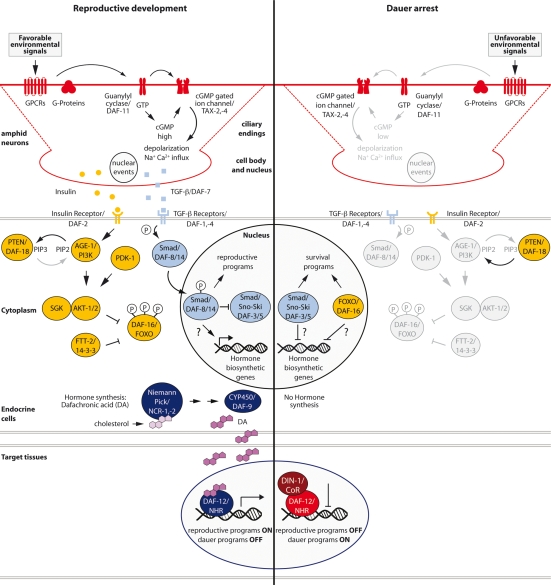Figure 2.
A model for the regulatory plasticity of dauer formation. Environmental cues (dauer pheromone and nutrients) are detected by GPCRs that reside in the ciliary endings of amphid neurons. These signals may be transduced via G-proteins together with the transmembrane GCY DAF-11, which converts GTP to cGMP. cGMP gated ion channels, TAX-2/TAX-4, transduce cGMP levels into ion influx. (Left) For reproductive development, high cGMP levels, directly or indirectly, lead to production of TGF-β (in ASI) and ILPs in amphids and other tissues. In endocrine cells (e.g., XXX, hypodermal, intestinal cells), binding of ILP agonists to the insulin/IGF-1 receptor DAF-2 results in activation of the AGE-1/PI3Kinase and PIP3 production. Presence of PI3 lipids and activating kinase PDK-1, leads to activation of AKT1,2 and SGK kinases, which phosphorylate DAF-16/FOXO, resulting in cytoplasmic retention by FTT-2/14-3-3 proteins. Binding of DAF-7/TGF-β to the DAF-1/4 receptor kinases results in phosphorylation of DAF-8 and DAF-14/ SMADs, and inhibition of DAF-3/SMAD and DAF-5/SNO-SKI complexes. Nuclear localization of DAF-8 and DAF-14 SMADs directly or indirectly regulates expression of hormone synthesis enzymes (e.g., DAF-9/CYP450), which produce dafachronic acids, the ligands for DAF-12/NHR. Niemann-Pick homologs NCR-1,2 deliver cholesterol and other sterols for use in hormone biosynthesis. In target tissues, liganded DAF-12 promotes reproductive and inhibits dauer programs. (Right) In dauer inducing conditions, low levels of cGMP diminish ILPs and TGF-β production. Down-regulated ILP and TGF-β production results in nuclear translocation of DAF-16/FOXO and DAF-3/DAF-5/SMADs to promote dauer programs and directly or indirectly inhibit expression of hormone biosynthetic genes. In target tissues, unliganded DAF-12 promotes dauer programs and through association with its corepressor DIN-1/SHARP represses reproductive programs. Note that the identified signaling pathways do not necessarily work in a strictly hierarchical fashion, can work in parallel, and have independent outputs.

